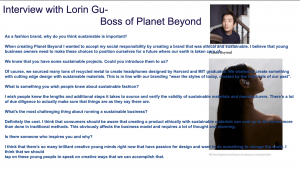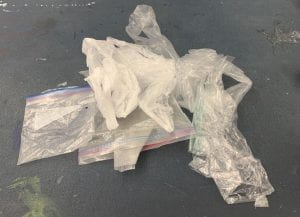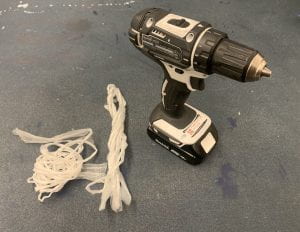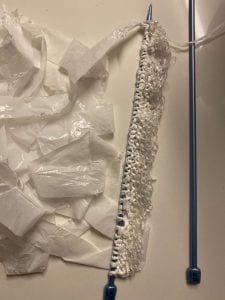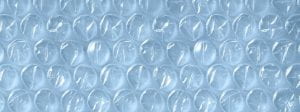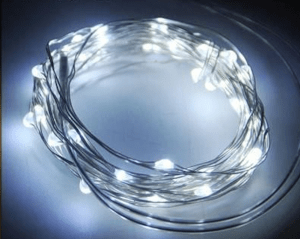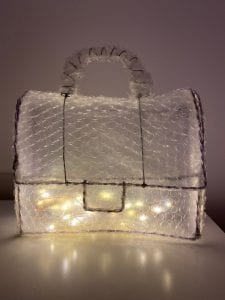As everyone knows, the fashion industry causes a great amount of pollution to the environment. There is a lot of news about plastic waste pollution. PET materials, such as plastic bottles, which constitute the main source of pollution, are actually the same as the raw materials of Polyester (Polyester) in our clothing industry.
If the raw materials can be changed from petroleum to recycled plastic bottles and recycled into chemical fiber fabrics.
1.Use trash to make new fabrics. (Plastic Yarn)
2.Use plastic bottles to make PVC fabric.(Lack of technical support)
3.Recycle waste wrapper to make some new fashion items or furniture.
Final Project:
Materials: Bubble wrap, wire and small light.
Final layout:
Sustainable development of fashion industry
Plastic pollution is reflected in every step of its production: manufacturing, use and disposal. Plastic is a material that the earth does not degrade naturally. Plastic will always be there, and even if it has been burned to ash, it will contaminate nature in the form of particles.
Most plastic waste is buried, recycled, burned or exported to other countries. Plastic recycling is expensive and does not deter the manufacture of new plastic products. Many people may think that plastic waste has little value, and even if recycled, it will only be made into cheaper plastic products. But in fact, PET, the raw material of beverage bottles, is made from petroleum. The abbreviation of PET plastic is Polyethylene terephthalate, because it has the characteristics of purity and fortitude, big is often used to make plastic bottles and polyester fiber, chemical fiber which is we used to make clothes.
There is a lot of news about plastic waste pollution. PET materials such as plastic bottles, which constitute the main source of pollution, are actually the same as the Polyester raw materials in our clothing industry.
If the raw materials can be changed from petroleum to recycled plastic bottles, these plastic bottles can be recycled into chemical fiber fabrics.
As everyone knows, the fashion industry causes a great amount of pollution to the environment.
Another big problem in the fashion industry has to do with the materials we use to make clothes. Polyester is one of the most common clothing materials. In the past 20 years, the growth rate of demand for synthetic materials has exceeded the demand for organic materials such as cotton, wool and flax. This trend has not slowed down: synthetic fibers are expected to account for 75% of global garment fiber production by 2030(Ta-Chang Kuo,2016).
Low price is the main reason for the use of synthetic materials: for brands, the materials they use not only need to bring a natural touch, but also the price that consumers are willing to bear. Polyester and cotton blends are cheaper than cotton, and most people think they feel very similar to organic fibers.
However, polyester clothing in washing will have very small micro fiber off. These microfibres pass through sewage treatment plants and eventually flow into water and the ocean, endangering aquatic life and the entire food chain.
People have been actively exploring the solution of synthetic fabric microfiber. Textile mission is a study sponsored by textile manufacturers and the Federal Ministry of education and research of Germany to reduce the emission of microplastic particles. At the same time, brands such as H & M and INDITEX (Zara) have increased the use of organic cotton (currently, the consumption of organic cotton is still less than 1% of the world’s annual consumption of cotton)( Li Yang,2018).
When the garment industry was still using oil to make PVC fabrics, and we didn’t know what to do with all that plastic waste.
I hope to reuse all kinds of plastic products that have had left unused and discarded and turn them into fashion items or household decorations.
I’m trying to do something new, although at this stage because of the limitations of biotechnology, it’s very difficult for me to make a completely new fabric that is very commercially viable for mass production. But for this final project. I took some of our household plastics and reworked them into a reusable fabric.
The bubble wrap that I use is come from my online shopping packaging. Because I liked the light penetration, I thought it might have multiple USES. Finally, I made A Bubble Wrap Bag/ Lamp by using Bubble Wrap, wire and small light.
I believe turning waste into treasures is a responsible way of life and beneficial to nature.
Of course, we can start from the details of life when we re-create the waste products. As the impact of artificial fiber on the environment is relatively large, so we can fill the washing machine as much as possible when washing clothes, because full load washing will reduce the friction between clothes, so less fiber is released. At the same time, washing liquid is used instead of washing powder: the “scrubbing” effect of powder particles will lead to loose fabric. Avoid high pH detergents and oxidants.
Wash clothes at low temperature. When washing clothes at high temperature, some fabrics will be damaged, resulting in fiber release. And longtime washing should be avoided. Long time washing will cause more friction between fabrics, which means the fibers will be torn. Use low speed for dehydration. The higher the rotation speed, the greater the friction between the clothes, and the greater the possibility of fiber loosening. When cleaning the dryer, do not flush the lint down the drain pipe, but throw it into the dustbin. Avoid buying synthetic clothing and use wool, cotton, linen, silk, cashmere or other natural fabrics.
As an outstanding fashion consumer who cares for the environment and supports the sustainable development of the clothing industry, I think it is not only to transform the waste, but also to start from the basic washing and care of clothes.
REFERENCE
Ta-Chang Kuo,Huann-Ming Chou.(2016). Estimation of the output of designer fashion industry in Taiwan. International Conference on Advanced Materials for Science & Engineering, 11(9),44-56
Li Yang(2018). Management Model for Garment Recycling Programs of Fast-fashion Brands: A Case Study of H&M. Journal of Management Case Studies, 2(1),30-44

